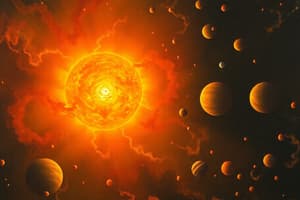Podcast
Questions and Answers
Which planet in our solar system is known as the 'Red Planet'?
Which planet in our solar system is known as the 'Red Planet'?
- Mars (correct)
- Mercury
- Earth
- Venus
What characteristic distinguishes Venus from Earth despite their similar size?
What characteristic distinguishes Venus from Earth despite their similar size?
- Lack of atmosphere
- Extreme temperatures and acid rain (correct)
- Presence of a protective magnetic field
- Heavily bombarded surface
Which planet in the inner solar system is the closest to the Sun?
Which planet in the inner solar system is the closest to the Sun?
- Mars
- Venus
- Mercury (correct)
- Earth
What makes Jupiter unique among the planets in our solar system?
What makes Jupiter unique among the planets in our solar system?
What distinguishes the inner solar system planets from the outer planets in terms of composition?
What distinguishes the inner solar system planets from the outer planets in terms of composition?
What is Jupiter's atmosphere primarily composed of?
What is Jupiter's atmosphere primarily composed of?
What distinguishes Saturn as the second largest planet in our solar system?
What distinguishes Saturn as the second largest planet in our solar system?
Why does Uranus appear almost sideways when viewed from Earth?
Why does Uranus appear almost sideways when viewed from Earth?
Which feature makes Neptune distinct from Uranus?
Which feature makes Neptune distinct from Uranus?
What provides valuable insights into the formation and evolution of the solar system apart from planets?
What provides valuable insights into the formation and evolution of the solar system apart from planets?
Study Notes
Understanding the Planets in Our Solar System
Our solar system is home to eight planets, each with distinct features and characteristics, orbiting the Sun at varying distances. These planets, along with numerous smaller bodies like asteroids, comets, moons, and dwarf planets, make up the intricate structure of our cosmic neighborhood.
Inner Solar System
The inner solar system, where Earth resides, is dominated by rocky planets. Mercury, the smallest and closest planet to the Sun, is a heavily bombarded world with no atmosphere. Venus, the second planet from the Sun, is similar to Earth in size but has a thick atmosphere filled with carbon dioxide, making it the hottest planet in our solar system. Despite being similar to Earth in terms of composition, Venus lacks a protective magnetic field, leading to extreme temperatures and acid rain. Earth, the third planet from the Sun, is the only known planet capable of sustaining life.
Outer Solar System
As we venture further out from the Sun, the planets become larger and more distant. These are known as the outer planets. Mars, the fourth planet from the Sun, is sometimes referred to as the 'Red Planet' due to the iron oxide (rust) on its surface. It is roughly half the size of Earth and has the tallest volcano in the solar system, Olympus Mons. Jupiter, the fifth planet from the Sun, is the largest planet in our solar system. It is composed mostly of hydrogen and helium gases, making its atmosphere brown with white clouds. Jupiter also possesses a massive magnetic field that is over 20,000 times stronger than Earth's. Orbiting around Jupiter are numerous moons, including the famous moon Europa, which scientists believe may contain an ocean beneath its surface.
Saturn, the sixth planet from the Sun, is known for its magnificent ring system composed of ice and rock particles. It is the second largest planet in our solar system, composed mostly of hydrogen and helium like Jupiter. Saturn's rings are thought to be comprised of debris from a moon that was torn apart by gravitational forces.
Uranus, the seventh planet from the Sun, is an icy, blue-green gas giant tilted at an extreme angle compared to other planets, which makes it appear almost sideways when viewed from Earth. Uranus is known for its "magnetic field" reversal, where magnetic north and south poles switch places every 14 years. Neptune, the eighth and farthest planet from the Sun, has a similar composition to Uranus but with stronger winds. Its most notable feature is the Great Dark Spot, a massive storm two times the size of Earth.
Small Bodies
Apart from these eight planets, the solar system also includes various small bodies such as asteroids, comets, dwarf planets, moons, interplanetary dust, and objects within the Kuiper Belt and Oort Cloud. These tiny celestial objects provide valuable insights into the formation and evolution of the solar system. One example is Pluto, now considered a dwarf planet, which orbits the Sun beyond Neptune. Triton, one of Neptune's moons, shares some characteristics of an inner planet due to its rocky core.
In conclusion, the planets of our solar system each have unique features that contribute to the diverse environment we call home. From the scorching temperatures on Venus to the icy landscapes of Uranus and Neptune, understanding these cosmic neighbors helps us comprehend not only the origins of life on Earth but also the potential for finding extraterrestrial life elsewhere in the universe.
Studying That Suits You
Use AI to generate personalized quizzes and flashcards to suit your learning preferences.
Description
Delve into the fascinating world of our solar system's planets, from the rocky terrains of Mercury and Mars to the massive gas giants like Jupiter and Saturn. Learn about the unique features and characteristics of each planet, along with the small bodies that populate our cosmic neighborhood.




